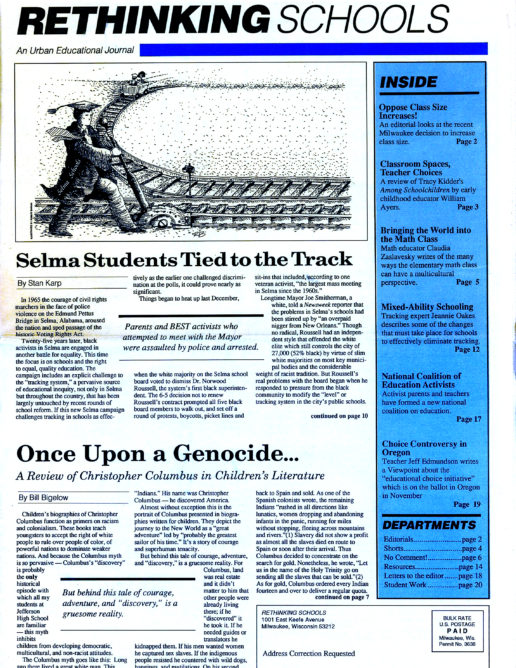Mixed-Ability Schooling: A Radical Proposition
The 19th-century common school symbolizes our heritage and commitment to democratic education. Yet for the past sixty years educators have developed separate curricula and grouped students according to ability in separate classrooms. A source of tension and controversy through the century, contradictions between the ideal of “common-ness” and the reality of “separateness” have surfaced again in the current press for school reform.
In response to recent proposals that a common or core curriculum could improve the quality of schooling, many educators and policymakers have begun to question their tracking and ability grouping practices. This questioning has been bolstered by a growing body of empirical evidence suggesting that tracking has been a generally ineffective means for educating diverse student populations and that, in fact, it probably works to the detriment of students who are placed in low-ability classes or non-college-prep programs, especially poor and ethnic minority students who are disproportionately represented. Perhaps even more startlingly, talented students are often found to achieve well in heterogeneous classrooms, dispelling many myths along the way.
Many educators no longer consider tracking simply as a neutral or passive conduit through which all students develop in their natural course toward different levels of aspiration and achievement. Many suspect that when schools react to individual differences with tracking, they encourage a reciprocal process that diminishes the educational success of children not in advanced groups. In addition, the most educationally impoverished programs are typically offered to the least able students. As a consequence, many schools have begun to think seriously about dismantling their current tracking systems.
As worthy as this impulse may be, however, a major caution is in order. Disappointing findings about tracking (and even promising evidence about heterogeneous grouping) should not lead anyone to believe that all evils will be solved simply by mixing students together. Heterogeneous schooling is a radical proposition; to be effective it will demand fundamental (perhaps revolutionary) changes in nearly every aspect of teaching and learning in the classroom.
It simply isn’t possible, for example, to teach diverse groups of students effectively when the curriculum is largely skill-based and rigidly sequential. Perhaps the most striking difference among students lies precisely in the speed with which they master the skills taught sequentially. Some students will race ahead; others lag behind. Quicker students often must be busied with makework; re-teaching others becomes a chore; being retaught (and often retaught again) becomes humiliation, particularly while others are waiting.
The curriculum well-suited to heterogeneous groups is of a very different nature. It is organized around central concepts and themes — the “big ideas” of a subject area. Mastering these ideas is important, challenging, complex, related to real life, and, most of all, rich with meaning. Indeed, it stretches the intellectual sense-making of all children. Students acquire skills as they become ready within a common conceptual framework.
If, on the other hand, conceptual learning is crowded out by rote memorization of facts, trivial assignments, or concerns such as deportment or neatness, then those students who can do more challenging work won’t, and those who can’t, won’t learn how. While a concept-based curriculum is far from simply a compromise to “do good” for slower or disadvantaged students, the range of differences will probably diminish greatly as an obstacle to teaching and learning.
In addition to reconstructing the curriculum, mixed-ability schooling will probably require dramatically altered instructional practice. In tracked classrooms, teaching typically consists of competitive whole-group instruction: lecturing, common assignments, uniform due dates and tests, and a single set of standards of competence and criteria for grades. Students in heterogeneous classes, however, benefit by being clustered in small groups exchanging ideas, sometimes working on separate but interrelated tasks, and generally helping each other learn. Teacher talk can’t dominate here; neither can large sessions of question and answer. Teachers function more like orchestra conductors than lecturers — getting things started and keeping them moving along; providing information and pointing to resources; coordinating the diverse but harmonious buzz of activity taking place.
In these classrooms, teachers can take advantage of a situation that enhances both the social and educational advantages of children talking and working together.
Children observe how others become successful. They can contribute in areas of strength while participating in and receiving help in areas where they do less well.
Talented students have the opportunity to elaborate on the ideas that come easily to them as they explain and demonstrate their knowledge to others. Despite (or perhaps because of) all the interaction among children, any one student’s strengths and weaknesses are seldom held up to the class for display, comparison, or embarrassment. Rewards in cooperative groups can be based on a shared goal which cannot be achieved unless each group member does their own best work. Individual grades based on improvement can provide even the least-skilled students with opportunities for success, while more skilled students are challenged because the artificial standard of simply doing better than their peers no longer brings easy rewards. The commonly expressed fear that better students will carry the poorer ones is rarely a significant problem, since conceptions of better and poorer quickly change when each student can make equally valued contributions to a group.
The reconstruction of school organization, curriculum, and classroom instruction required for successful mixed-ability grouping is a mind-boggling proposition. Even so, these changes touch only the technological side of tracking. Such a change will also demand radically altered assumptions about students, learning, and the purpose of schooling. Just as tracking assumes that some students can’t or won’t learn, successful heterogeneity requires the belief that all students can and will.

